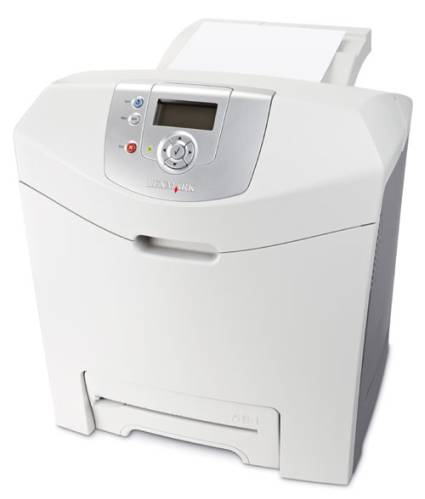Color Laser Printers: Fast and Affordable!
Lexmark C522n
While the C522n is a success esthetically and ergonomically, it has many shortcomings. In particular, its performance is not up to the manufacturer's claims.
Ergonomics And Functions
Ergonomics is one of this printer's strong points. Its large LCD display makes for easy navigation in the menus, and it can graphically display information on the location of a paper jam or a consumable that needs replacing. Its housing is large but vertically oriented, so the footprint is reduced. At around 57 lb (26 kg), it's also fairly light (relatively speaking!)
Printing Speeds
Lexmark claims a speed of 19 ppm in monochrome, but our tests showed that actual performance was far below that level. The printing engine itself is capable of attaining such speeds, but the printer executes a color recalibration procedure that sometimes takes more than a minute, considerably increasing printing times. The best speed we clocked was 6.4 ppm, or barely faster than a multi-pass model. The driver's calculation time is also very long, which results in a time to first page that's well in excess of the other models tested in this article. It took over a minute to print our Photoshop document - three times as long as the Color LaserJet 3600.
Print Quality
Like the Magicolor 5430DL, the Lexmark C522n had trouble convincingly displaying details in the images. Small white dots on a red background didn't show up, and certain lines on our Excel graph were barely visible. On the other hand, with documents that were a mixture of text and graphics, it did fine.
Get Tom's Hardware's best news and in-depth reviews, straight to your inbox.
Cost Per Page
Lexmark's policy regarding its cartridges can result in wide variations in cost per page. The manufacturer offers two types of cartridges: standard ones, and ones recycled from the Lexmark Return Program (LRP). These latter cartridges are 30% to 40% less expensive than the standard cartridges, and they're the ones we used to calculate the cost per page for this article. At 3 and 14 cents in black and color, respectively, that cost was relatively high, but with standard cartridges it would have been around 5 and 20 cents. Note that high-capacity cartridges aren't available for this printer, while they are for its big brother (the C524n), which uses exactly the same printing engine.
Conclusion
Despite its handsome looks and standard network port, the C522n has too many faults. Lexmark really needs to work on its warm-up procedure and its driver so that this printer's engine can fulfill its great promise.
-
veffari I honestly don't feel any closer after going through this interview. Consumer-end color laser printers have their real limitations. I have one (Minolta) that's been very useful for years but not useful enough.Reply
How about sticking an envelope in the printer. What happens then, does it come out wrinkled? Does the text get evenly put on? Or a cardstock, does the printer handle it and what weights and types? Does the cardstock come out bent? Do the printers handle vellum paper, transparencies, do they have to be hand-fed or does the printer jam when the user gets more creative than your average office drone?
Is the program interface quick and easy to understand or a time-eater?
I feel the reviewers should get a little more creative here. A review measuring speed is ok, but in reality versatility is more important than a sceond or two here or there on paper outputs. It makes no real-world difference if one machine does 23 seconds or the other 24 seconds, really. Unless were talking 1 minute per page vs 45 seconds: In the end, is the machine going to print nice brochures that have not to bright colors or certain colors that become to vivid and muddy? Or is it just good for a quick presentation for an informal meeting? Does it easily perform on commonly found laser copy paper? Is it easy to calibrate colors with Photoshop? Do you recommend certain paper types that produce beautiful results and guide us to who makes them so we can use the machine better after we buy it on your recommendation?
And how about doing a review on professional level color laser printers? Like $1000-$4000 models. Some of those have really amazing qualities in text and photos, but I'd like to know how they compare. After all my dozen broken inkjets I realized long time ago they are there to perform temporarily and designed to not really be workhorses.
So how does it last? Does the printer last and does the output last? Do you put printouts in the sun, on the radiator, or spray steam on them for humidity simulation and such?
The output image files are a bit confusing and could be expanded on. Side by side comparisons where the reviewer notices differences. Not just stick them in the article.
Boy, I have more questions after reading the review than when I started reading. Much of the info is in semi-techno or owners manual style. It would be nice to get beyond it and TEST the machines and have strong opinions and say why.
